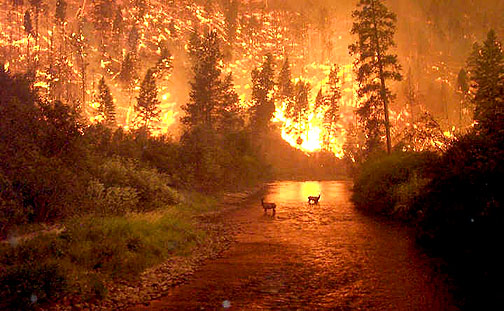
|
Fire Season 2000
|
|
|
|
East Fork of the Bitterroot River |
|
Photo by J. McColgan |
| On August
19, 2000 a wind-driven fire exploded out of Chicken Creek canyon, rushed down
to Alta Meadow - and stopped. Located well away from the forest,
with metal roofs, and surrounded by green grass, the cabins were not seriously
threatened by the blaze that scorched the hills to the
southwest. Some of the western slopes were subjected to a slow burn
over the next ten days - largely leaving mature trees unharmed.
As you likely know, the West was ablaze the long summer of 2000, and the southern Bitterroot Mountains were particularly hard hit. All of this destruction begs the question: why? The answer is controversial, but some conclusions seem obvious. This was a hot, dry summer with winds out of the southwest, bringing Arizona's weather to western Montana. Add frequent, dry thunderstorms - with thousands of lightening strikes, and forest fires were inevitable. We often hear that these fires are part of the natural order, and indeed some fires are. Mountain plants are well adapted to "natural fires", but the conflagration of 2000 was far from natural. The combination of fire suppression and logging have profoundly altered the natural order. Before logging was widespread, Ponderosa Pine forests dominated this area, and fires consumed mainly "understory" - small trees and wood debris. This type of fire is natural and beneficial. After logging, Lodgepole Pine replaced the larger Ponderosa variety. Lodgepole forests are dense (with perhaps 800 trees per acre) and they have a shorter life span - filling the forest with more debris - i.e. fuel. There is also the concept of "fire ladders" in a densely packed forest. A ground fire first ignites small trees - the medium sized trees are next, and soon, up in the canopy, fire is racing on the wind. The scenario is entirely different in a mature Ponderosa forest with its 60 trees per acre. When small trees burn, fire might spread to a fallen limb, a nearby bush, some pine needles - but the mature trees are spared. Another consequence of commercial logging is the addition of "slash" to the equation. Failure to clean up the massive amount of debris after a logging operation is an invitation to harmful insects - and more devastating fires. The proclamation "clear cuts don't burn" is a myth. They are often choked with slash and small, densely packed (and therefore unhealthy) trees - all prime fuels. The blame game will play on and there will be debate about what to do. But it is not as if solutions are so mysterious. The forest has already shown us how to survive wild fires; we need to pay attention. Methodology may be a matter for discussion, but we should acknowledge the wisdom of the ancient order - and try to emulate it. It is hoped that by realizing there is only one part of the equation humans can alter, the character of the forest, some good will come from this loss. Humans have intervened massively, and with disastrous results; we have a solemn obligation to nurture the forest back to health. One silver lining in a smoky cloud - the likelihood of a serious fire in the future has been greatly diminished. The mosaic pattern of the fire, dependent on topography and weather, has provided firebreaks all around, while leaving large swaths of the hillsides unharmed. And we shall witness the miracle of regeneration - the healing that has already begun. |
|
Click on an image to enlarge it. |
|
Razor Fire's origin Chicken Creek drainage Hilltop burn |
|
Anatomy of a fire Northern Rockies from space Southern Bitterroots |
Homepage |
Cabins | Activities | Reservations |
Location
© 1998 ALTA MEADOW RANCH, ALL RIGHTS RESERVED.